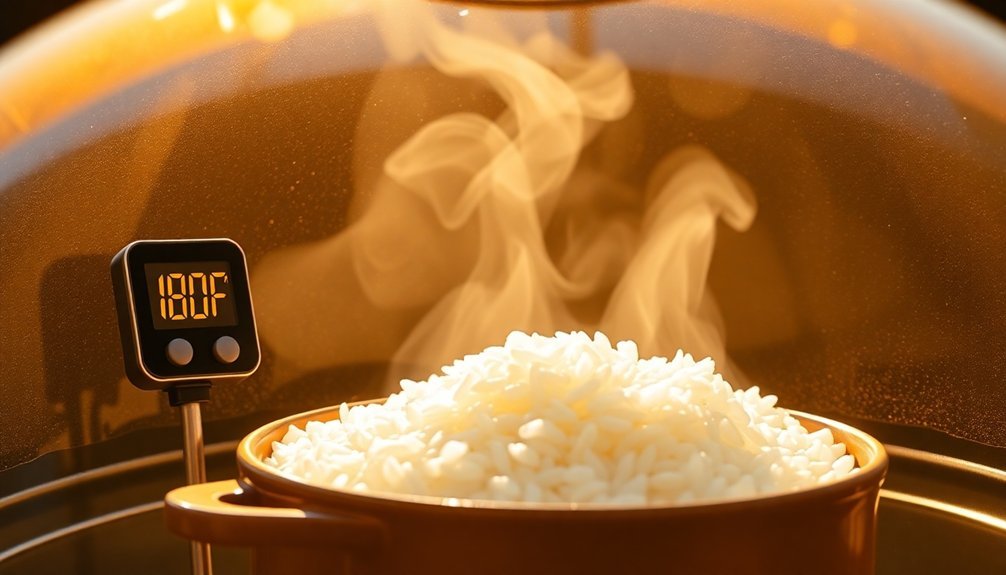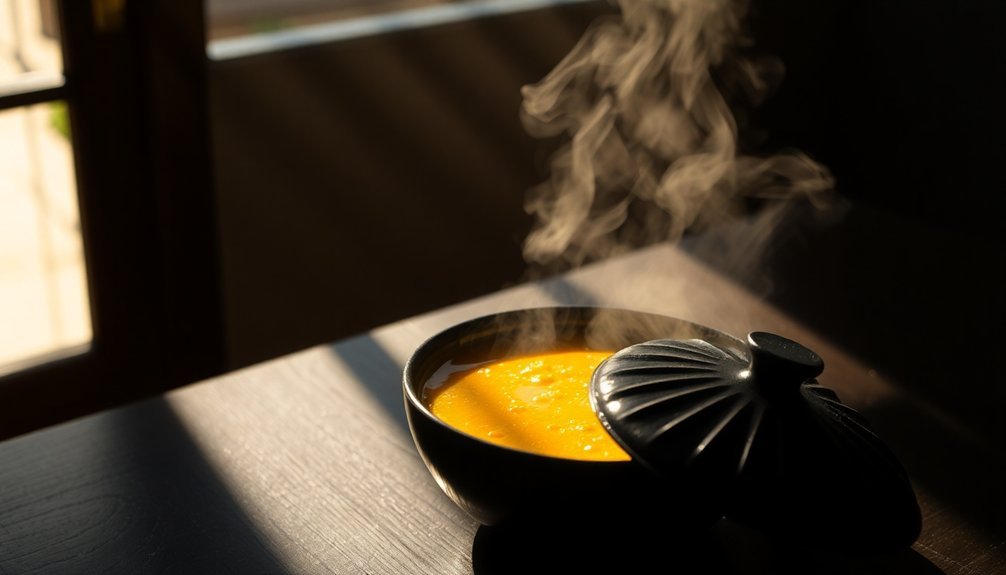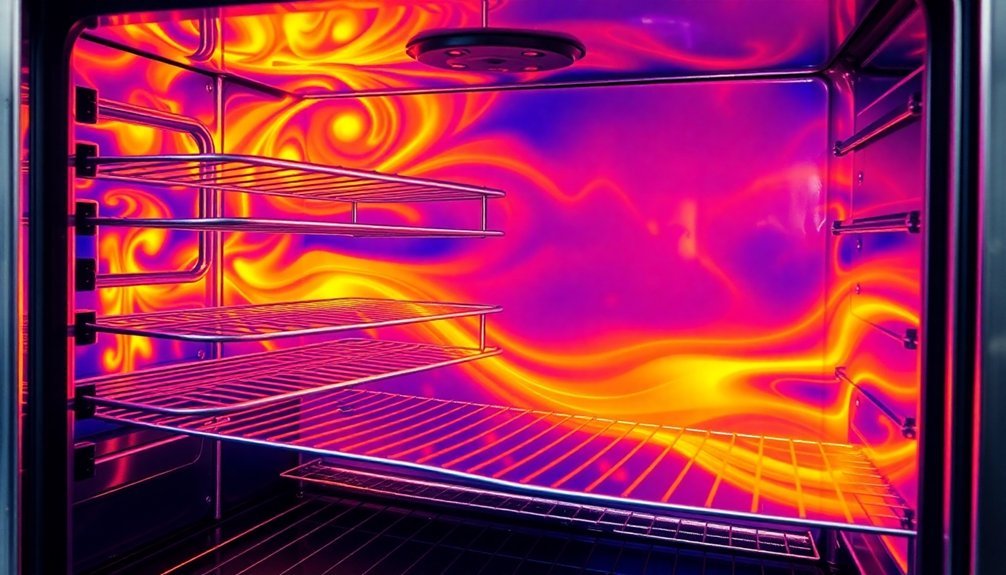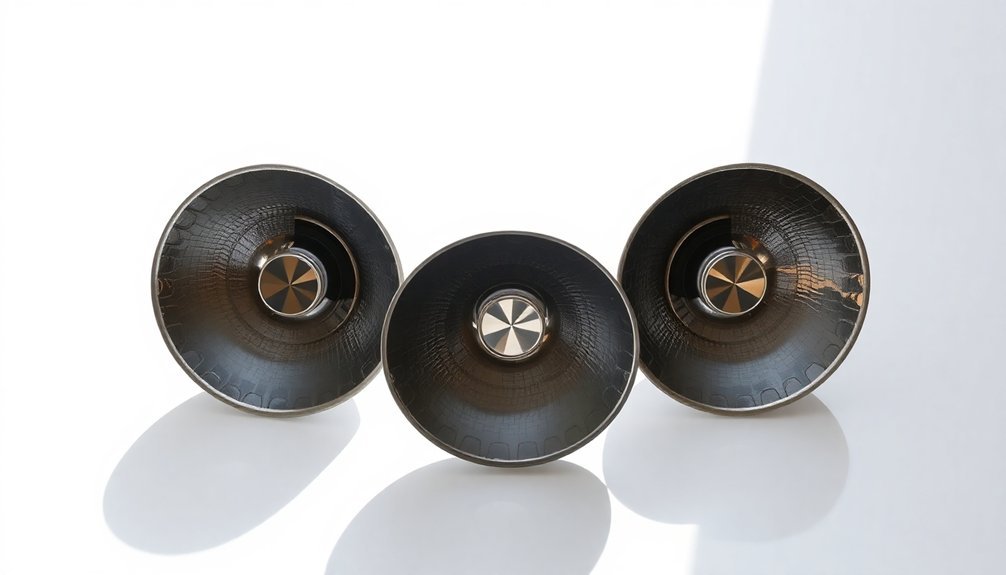Your ideal cooking temperature for rice in a solar oven should be between 300°F to 400°F (149°C to 204°C). You'll need to monitor the temperature using an oven thermometer and adjust your reflectors every 30-45 minutes to maintain this range. Position your oven in direct sunlight between 11:00 am and 3:00 pm for best results. Different rice varieties require specific timing: white rice takes 20-35 minutes, basmati needs 30-35 minutes, and brown rice requires 40-45 minutes. Keep the lid closed during cooking and use dark-colored pots for better heat absorption. Understanding weather conditions and seasonal variations will help you master solar rice cooking.
Ideal Solar Oven Temperature Range

The sizzling potential of a solar oven depends heavily on achieving and maintaining the right temperature range. For your rice to cook properly, you'll need to reach at least 180°F (82°C), though ideal cooking occurs between 300°F and 400°F (149°C to 204°C).
While some advanced parabolic cookers can hit impressive temperatures up to 800°F (427°C), you'll typically work with more moderate ranges when cooking rice.
If you're using a box-type solar oven, you can expect temperatures between 160°F to 400°F (71°C to 204°C), while panel cookers operate in the 200°F to 300°F (93°C to 149°C) range.
To maintain these temperatures effectively, you'll need to focus on several key factors. Make sure you're cooking during peak hours between 11:00 am and 3:00 pm when the sun's directly overhead. Installing reflective aluminum foil panels can significantly boost your cooking temperature.
You'll also want to check that your oven's insulation is working properly and all gaps are sealed to prevent heat loss. Using dark-colored cookware will help absorb solar energy more efficiently, and you should preheat your oven for about an hour before adding your rice.
Temperature Zones For Different Rice
When cooking with different rice varieties in your solar oven, each type demands specific temperature ranges for ideal results. While most rice varieties cook well between 82-121°C (180-250°F), you'll need to adjust cooking times and water ratios based on the specific type you're using. The slow cooking method of sun ovens helps preserve the natural flavor and nutrients of your rice.
- White rice cooks fastest at 20-35 minutes and requires water to reach 100°C (212°F) for proper absorption.
- Basmati rice needs 30-35 minutes with a 2:1 water ratio and benefits from post-cooking fluffing.
- Brown rice requires longer cooking (40-45 minutes) due to its fiber content and harder outer shell.
- Specialized varieties like Japanese and Thai rice cook in 20-30 minutes with a 1:1.5 to 1:2 water ratio.
For ideal results, make sure your solar oven maintains consistent temperatures throughout the cooking process.
You'll know your rice is done when small holes appear on the surface and all water is absorbed.
Remember to let your rice rest for 10 minutes after cooking, allowing residual steam to complete the process. This resting period is vital for achieving the perfect texture, regardless of the variety you're preparing.
Monitoring Heat Distribution

You'll need to monitor the solar oven's heat zones carefully to achieve perfectly cooked rice, as uneven temperatures can lead to inconsistent results.
Position your cooking vessel in the center of the oven where heat distribution is most uniform, and use the real-time temperature monitoring system to track any fluctuations. Apps can help you validate cooking conditions through data logging features.
Regular adjustments to your solar oven's position throughout the cooking process will help maintain consistent temperatures across all zones, ensuring your rice cooks evenly from edge to center.
Heat Zones Matter Most
Understanding heat zones in your sun oven holds the key to perfectly cooked rice every time. You'll need to maintain temperatures between 300-350°F (149-177°C) for ideal results, and knowing how heat distributes throughout your oven makes all the difference.
Using an oven thermometer, you can monitor these zones and make necessary adjustments to guarantee even cooking.
- Position black pots and pans strategically to maximize heat absorption and retention
- Look for small holes forming on the rice's surface to indicate proper water absorption
- Watch for condensation patterns that signal even heat distribution
- Monitor shadow alignment to maintain consistent heating zones
Your sun oven's heat zones aren't static – they'll shift as the sun moves across the sky. You'll need to adjust the oven's position periodically to maintain ideal heat exposure.
By using well-insulated cookware and high-temperature baking bags, you can create stable heat zones that cook your rice evenly.
Remember to let your rice rest for a few minutes after cooking to allow residual steam to complete the process. The combination of proper heat zone management and careful monitoring will consistently produce perfectly cooked rice in your sun oven.
Even Cooking Through Positioning
For consistently cooked rice, proper positioning of your sun oven is essential to maintain even heat distribution. You'll need to place your oven in direct sunlight and adjust its angle throughout the cooking process to maintain ideal temperatures between 325-350°F. Use a leveling tray to prevent uneven cooking and guarantee your rice cooks uniformly.
| Time of Day | Oven Position | Expected Temperature |
|---|---|---|
| 10:00 AM | East-facing | 325°F |
| 11:30 AM | Southeast | 340°F |
| 1:00 PM | Direct South | 350°F |
| 2:30 PM | Southwest | 340°F |
| 4:00 PM | West-facing | 325°F |
To maximize heat distribution, you'll want to rotate your oven every 30 minutes to follow the sun's path. Keep the reflective panel properly angled to capture maximum sunlight, and use dark, tight-fitting lids on your cooking pots. Don't forget to maintain the oven's airtight conditions by minimizing door openings. If you're planning an evening meal, start cooking earlier and orient your oven slightly westward to compensate for the sun's movement. This positioning strategy helps maintain consistent cooking temperatures throughout the 30-35 minute cooking cycle.
Adjusting Reflectors For Heat Control
You'll need to position your solar cooker's reflectors carefully to achieve the ideal cooking temperature for rice, typically adjusting the angles based on the season and time of day.
For maximum heat control, use the eyeballing method to verify the sun's rays are properly concentrated on your cooking pot, and tilt the reflectors more steeply during winter months when the sun is lower.
To collect the most sunlight, regularly monitor and readjust your reflectors as the sun moves, keeping the angles equal on arrival and reflection while maintaining a stable platform for your rice pot.
Reflector Positioning For Heat
Proper reflector positioning plays an essential role in controlling your rice cooker's heat levels. You'll need to make precise adjustments to maintain the ideal temperature for perfectly cooked rice.
Stand behind your sun oven and guarantee the shadows are even on both sides, then tilt the oven until you've eliminated shadows in both front and back chambers.
- Use the E-Z Sun-track indicators to center the light dot over the bottom hole
- Adjust the alignment leg's height to maintain proper sun orientation
- Secure reflectors firmly with the thumbscrew turned one-quarter
- Install wire stakes through the alignment leg base for stability on windy days
To maximize heat capture, aim the front of your oven directly at the sun and regularly check its positioning throughout the cooking process.
You'll want to adjust the reflectors to direct additional solar energy toward your cooking surface. The alignment leg helps you raise or lower the oven's orientation to meet the sun on the horizon.
For consistent cooking temperatures, guarantee your reflectors remain securely in place and properly aimed at the sun throughout the entire rice cooking process.
Seasonal Angle Adjustments
Seasonal adjustments to your solar oven's reflector angles are essential for maintaining consistent cooking temperatures throughout the year.
You'll need to adjust your oven's tilt angle every 30-45 minutes to follow the sun's path, ensuring ideal heat capture for cooking rice.
For the best results, plan your rice cooking between 11:00 am and 3:00 pm when the sun is directly overhead. If you're cooking during shorter winter days, you can extend these hours from 10:00 am to 4:00 pm, but you'll need more frequent angle adjustments to maintain temperature.
Use the E-Z Sun-track indicators to properly align your oven, and in winter months, you might need to lay the oven on its back for proper positioning.
Don't forget to secure your oven against wind interference. You can use wire stakes to anchor the alignment leg and lock reflectors with thumbscrews for stability in winds up to 35 MPH.
While 55 degrees serves as a good year-round angle, you'll need to modify this based on your latitude and seasonal variations.
Maximizing Light Collection Methods
Sunlight collection efficiency directly impacts your rice cooking success in a solar oven. To maximize heat generation, you'll need to focus on precise reflector positioning and material selection. Position your cooker in a flat, south-facing location and use a brightly colored object to mark your target cooking zone.
- Use a protractor or template to set exact angles, adjusting reflectors every 15-30 minutes.
- Select highly reflective surfaces like polished aluminum or vinyl car wrap for peak performance.
- Keep reflector surfaces clean and check regularly for damage or wear.
- Maintain a 15° tolerance during unattended cooking periods to guarantee consistent heating.
Guarantee the top reflector's rays hit the opposite side of your cooking target to create an intense heat zone. You'll want to center your rice cookware at the focal point where heat concentration is highest.
Don't forget to inspect for shadows and reposition panels if needed. For enhanced efficiency, line the oven lid and bottom with reflective materials, and seal all edges properly to retain heat.
When selecting reflective materials, consider that Mylar tape offers quick heat reflection, while aluminum foil tape provides a practical balance of cost and effectiveness.
Weather Impact On Cooking Temperature

Weather conditions play an essential role in how you'll need to adjust your cooking temperatures for perfect rice. When you're using a sun oven, you'll notice that high temperatures lead to faster cooking times, while cold or cloudy weather greatly extends the cooking duration.
You'll need to plan accordingly, especially during winter months when cooking times can double.
Humidity levels will affect your rice's cooking process too. In high-humidity conditions, you might need to reduce the amount of water you add to your rice, as moisture evaporation occurs more slowly.
Conversely, in dry conditions, you may need to add slightly more water to compensate for faster evaporation.
If you're cooking at higher altitudes, you'll face unique challenges since water boils at lower temperatures. You'll need to extend your cooking time and possibly increase the water-to-rice ratio to achieve the desired texture.
On windy days, your sun oven's temperature might fluctuate more than usual, so you'll want to position it in a sheltered spot while still maintaining maximum sun exposure.
During rainy or snowy weather, it's best to use alternative cooking methods, as sun ovens won't maintain consistent temperatures.
Preheating Your Solar Oven
Proper preheating of your solar oven stands as the foundation for successful rice cooking. You'll need to preheat for at least one hour to reach ideal temperatures, though you can start as early as 10:00 AM if you're planning to brown ingredients.
During preheating, verify your oven faces directly into the sun with the glass door closed and latched.
- Stand behind your solar cooker and align it so its shadow falls directly behind it
- Keep the cover completely zipped during both preheating and cooking processes
- Use oven mitts when handling the hot surfaces after preheating
- Check that there are no shadows inside the cooking chamber
You'll need to realign your solar oven every 30 minutes to maintain maximum effectiveness, especially during winter months or shorter days.
In summer, you can leave it unattended for longer periods. For the best results, make sure your oven's positioned to capture direct sunlight, with reflectors properly adjusted to focus light into the cooking chamber.
If you're using a DIY model, prop the reflector flap open and verify the outdoor temperature is at least 85°F for ideal performance.
Temperature Maintenance During Cooking

To maintain ideal temperature while cooking rice in your solar oven, you'll want to keep the lid closed as much as possible and use dark-colored pots with tight-fitting lids to maximize heat retention.
You can control the temperature by adjusting your oven's position every 30 minutes to track the sun's movement, ensuring it stays perpendicular to the rays.
Keep an eye on the built-in thermometer to maintain temperatures between 350°F and 400°F, making necessary adjustments to the reflector panels if the temperature drops.
Heat Retention Tips
Maintaining consistent heat levels while cooking rice requires careful attention to both equipment and technique. To maximize heat retention in your sun oven, use a dark, non-reflective pot with a tight-fitting lid. You'll want to avoid opening the oven frequently, as this can cause significant temperature drops that will affect your rice's cooking time and texture.
- Use high-temperature oven bags as an extra layer of insulation around your cooking pot
- Select thin black metal pots that absorb heat effectively rather than reflective containers
- Keep the oven's glazing clean and properly sealed to trap heat inside
- Position a pot holder beneath your cooking vessel to prevent heat loss through the bottom
For best results, make sure your pot remains stable on a leveling tray throughout the cooking process. If you're using thermal mass materials, place them strategically around your cooking vessel to maintain steady temperatures.
Don't use aluminum foil to cover your rice, as it reflects heat away from the food instead of retaining it. When checking your rice, work quickly to minimize heat loss, and always reseal the oven tightly.
Remember to maintain the oven's position relative to the sun for consistent heating throughout the cooking period.
Temperature Control Methods
Successful temperature control in solar rice cooking depends on careful monitoring and consistent adjustments throughout the cooking process.
You'll need to maintain temperatures between 150-225°F for ideal rice cooking, using a reliable thermometer or Type-K thermocouple for precise readings.
Position your solar oven to directly face the sun and adjust it every 30-45 minutes to maintain consistent heat.
You'll want to use the reflective panels strategically to direct additional sunlight onto your cooking surface.
If your oven has E-Z Sun-track indicators, use them to guarantee proper alignment throughout the cooking period.
Before adding your rice, preheat the oven for 20-30 minutes to reach the desired temperature.
Keep track of temperature fluctuations as the sun moves, and reposition your oven accordingly.
You'll need to secure the oven with wire stakes on windy days to maintain stability and consistent heating.
Use real-time tracking and data visualization tools to monitor temperature patterns.
This will help you predict and adjust cooking times accurately, making sure your rice cooks evenly without burning or undercooking.
Rice Cooking Time And Temperature
When cooking rice in a sun oven, temperature control and timing are essential for achieving perfectly cooked grains. You'll want to maintain a temperature between 300°F to 350°F for ideal results, guaranteeing your sun oven is properly preheated before adding your rice mixture.
- Use a 1:1.5 or 1:2 rice-to-water ratio, adjusting based on your preferred rice consistency.
- Expect cooking times of 30-60 minutes for standard portions, with larger quantities taking up to 2 hours.
- Position your sun oven to maintain consistent temperature throughout the cooking process.
- Choose black pots with lids to maximize heat retention and cooking efficiency.
For the best results, you'll need to monitor both temperature and cooking duration carefully. Start by preheating your sun oven and using leveling trays to guarantee even heat distribution.
Once you've added your rice and water mixture, you'll want to check and adjust the oven's position with the sun to maintain steady temperature. After cooking, let your rice rest for a few minutes to absorb any remaining liquid and achieve the perfect texture.
Heat Loss Prevention Methods

Effective heat loss prevention stands as a critical factor in sun oven cooking performance. To maintain the ideal temperature for cooking rice, you'll need to implement multiple glazing systems and strategic sealing techniques.
Double-paned glass panels with precise air spacing will minimize convection heat loss, while high-temperature silicone caulk guarantees a proper seal against moisture and dirt.
You'll want to maximize heat retention by using dark materials throughout your cooking setup. Line your cooking cavity with black paint or dark clay, which can absorb up to 95% of incoming solar radiation. Use dark-colored pots with lids, preferably thin ones that heat up quickly and maintain cooking temperatures effectively.
For peak insulation, surround your cooking area with spun fiberglass, rockwool, or polystyrene sheets on all non-glazed surfaces. Add aluminum foil as a radiant reflector, and don't forget to incorporate crumpled newspaper for additional insulation.
Seal your oven's opening with clear plastic wrap or heavy-duty cooking bags, and secure the lid using clamp-style paper clips. This thorough approach to heat loss prevention will help maintain the consistent temperature needed for perfectly cooked rice.
Solar Position And Temperature
Understanding solar position proves essential for achieving ideal rice cooking temperatures in your sun oven. You'll get the best results between 11:00 am and 3:00 pm when the sun's at its highest point, providing maximum heat concentration for cooking your rice.
To maintain consistent temperatures, you'll need to adjust your oven's position every 30 minutes to track the sun's movement across the sky.
- Position your sun oven in a south-facing direction (in the Northern Hemisphere) to capture the most direct sunlight
- Choose a location that's protected from wind to prevent heat loss and maintain stable temperatures
- Clean your reflectors and glass door thoroughly before each use to maximize heat absorption
- Consider your latitude – if you're closer to the equator, you'll have more consistent cooking times year-round
Your location's latitude greatly impacts cooking performance. If you're cooking rice in higher latitudes, you'll need to plan around shorter winter days and less direct sunlight.
During summer months, however, you can take advantage of up to 13 hours of cooking time in southern latitudes. Remember that even in cold temperatures, your sun oven can effectively cook rice as long as there's enough direct sunlight to cast a shadow.
Temperature Testing Equipment

Accurate temperature monitoring requires specific equipment to achieve perfect rice cooking results.
You'll need thermocouples for sensing both water and air temperatures during the cooking process. Position each thermocouple junction 10mm above your cooking vessel's bottom, guaranteeing it's fully immersed in the water.
When installing your thermocouples, you'll need to pass the leads through the cooking vessel's lid using a thermally nonconductive sleeve. It's vital to seal this sleeve with 100% silicone caulk to prevent water vapor loss.
You'll want to record temperatures in Celsius to the nearest tenth of a degree every ten minutes.
Your testing setup should include a radiation pyranometer to measure available solar energy. Mount it perpendicular to direct beam radiation, and you can fix it at the average beam radiation zenith angle.
You'll also need an electronic balance that measures water mass to the nearest gram – remember to use pre-wetted containers for accurate measurements.
When monitoring ambient conditions, verify your wind instrumentation is placed in the same wind shadow as your cooker, and use wind shelters if needed, but don't let them interfere with incoming solar radiation.
Seasonal Temperature Variations
Throughout the year, solar rice cooking temperatures fluctuate considerably with seasonal changes. Summer offers the most favorable conditions, with solar ovens reaching up to 400°F during peak hours, making it perfect for cooking rice quickly and efficiently.
Spring follows as the second-best season, maintaining temperatures up to 300°F, which is still excellent for rice preparation.
- Summer's intense UV rays (11 am – 3 pm) let you cook rice without frequent oven adjustments
- Spring's moderate temperatures (18-25°C) provide consistent cooking conditions
Fall requires longer cooking times due to temperatures dropping to 140-160°F.
Winter needs strategic planning with more frequent sun tracking and proper insulation.
Fall and winter present more challenges for solar rice cooking. You'll need to adapt your cooking strategy during these seasons, often extending cooking times or splitting the process across multiple days.
In fall, temperatures hover between 140-160°F, while winter can still achieve up to 350°F with proper insulation and positioning.
To maintain consistent results year-round, you'll want to adjust your cooking schedule to maximize exposure during the peak hours of 11 am to 3 pm, regardless of season.
Temperature Troubleshooting Tips

Most solar rice cooking problems stem from incorrect temperature management. You'll need to maintain temperatures between 180°F and 250°F for properly cooked rice. If you're experiencing issues, first check your oven thermometer to confirm you're within this range.
When temperatures drop below 180°F, your rice will likely remain undercooked. To fix this, you'll need to adjust your sun oven's position every 20 minutes to track the sun's movement.
If you're getting temperatures above 250°F, you're risking burned rice. Use dark, shallow pots and cooking bags instead of aluminum foil to help regulate heat distribution.
You can tell if your temperature control is working by watching for steam and condensation inside the oven. Small holes forming on the rice's surface indicate proper water absorption.
If you're cooking on a cloudy day, expect to double your cooking time, as temperatures will likely hover between 200°F and 250°F. Use a meat thermometer to verify doneness if you're unsure.
Frequently Asked Questions
Can Different Colors of Cooking Pots Affect Rice Cooking Temperature?
Yes, your pot's color markedly affects cooking temperature. You'll find dark-colored pots absorb and retain heat better than light ones, which means they'll reach higher temperatures faster when cooking rice.
Does Altitude Impact the Optimal Temperature for Cooking Rice in Sun Ovens?
While altitude won't change your sun oven's ideal temperature, it'll affect water's boiling point. You'll need to adjust cooking times and water ratios since water boils at lower temperatures in higher elevations.
How Does Rice Soaking Time Affect Required Cooking Temperature?
While you'll need to maintain 98°C for proper cooking, your rice soaking time won't change this required temperature. Soaking only affects water absorption and texture, not the essential heat needed for gelatinization.
Will Using Distilled Versus Tap Water Change the Cooking Temperature Needs?
You won't need to change cooking temperatures whether you use distilled or tap water. Both types have similar boiling points and cooking behavior. It's more important to focus on maintaining proper water-to-rice ratios.
Can Metal Versus Glass Lids Influence the Internal Cooking Temperature?
Yes, your lid choice affects internal temperature. Metal lids typically create higher temperatures due to better heat conductivity, while glass lids allow heat escape through radiation but let you monitor cooking without lifting the lid.
In Summary
You'll find that maintaining 180-200°F (82-93°C) is ideal for cooking rice in your sun oven. Remember to adjust your reflectors throughout the day and use a reliable thermometer to monitor the temperature. Don't let cloudy conditions discourage you – you can still achieve good results by extending cooking time and maximizing heat retention. With practice, you'll master temperature control for perfectly cooked solar rice.





Leave a Reply